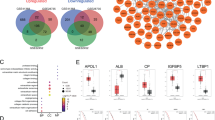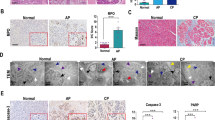Abstract
Pancreatic cancer still remains one of the most lethal diseases and establishment of new therapy is needed. The purpose of this study is to find novel factors involved in pancreatic cancer progression by proteomic approach. We compared pre- and postoperative serum protein profiling obtained from pancreatic cancer patients who had curative pancreatectomy using surface-enhanced laser desorption ionization time-of-flight mass spectrometry. The peak intensity levels of both 6630 and 6420 Da were significantly higher in the preoperative serum than in the postoperative serum (P<0.002). Sequential amino acid analysis identified these proteins to be apolipoprotein C-1 (ApoC-1). The high level of ApoC-1 in preoperative serum significantly correlated with poor prognosis. Furthermore, ApoC-1 was abundantly expressed in pancreas neoplastic epithelium, and was detected in the culture medium of the pancreatic cancer cell line in vitro, which suggests that cancer cells secrete ApoC-1. Inhibition of ApoC-1 expression by short interfering RNA suppressed cell proliferation and induced apoptosis of pancreatic cancer cells. The specific expression of ApoC-1 and its role in preventing from spontaneous apoptosis in pancreatic cancer cells suggest that ApoC-1 contributes to the aggressiveness of pancreatic cancer and will be useful as a new therapeutic target.
This is a preview of subscription content, access via your institution
Access options
Subscribe to this journal
Receive 50 print issues and online access
$259.00 per year
only $5.18 per issue
Buy this article
- Purchase on Springer Link
- Instant access to full article PDF
Prices may be subject to local taxes which are calculated during checkout







Similar content being viewed by others
References
Bardeesy N, Depinho RA . (2002). Pancreatic cancer biology and genetics. Nat Rev 2: 897–909.
Burris III HA, Moore MJ, Andersen J, Green MR, Rothenberg ML, Modiano MR et al. (1997). Improvements in survival and clinical benefit with gemcitabine as first-line therapy for patients with advanced pancreas cancer: a randomized trial. J Clin Oncol 152: 2403–2413.
Chen X, Lin J, Kanekura T, Su J, Lin W, Xie H et al. (2006). A small interfering CD147-targeting RNA inhibited the proliferation, invasiveness, and metastatic activity of malignant melanoma. Cancer Res 66: 11323–11330.
Chen YC, Pohl G, Wang TL, Morin PJ, Risberg B, Kristensen GB et al. (2005). Apolipoprotein E is required for cell proliferation and survival in ovarian cancer. Cancer Res 65: 331–337.
Ehmann M, Felix K, Hartmann D, Schnolzer M, Nees M, Vorderwulbecke S et al. (2007). Identification of potential markers for the detection of pancreatic cancer through comparative serum protein expression profiling. Pancreas 34: 205–214.
Fadok VA, Voelker DR, Campbell PA, Cohen JJ, Bratton DL, Henson PM . (1992). Exposure of phosphatidylserine on the surface of apoptotic lymphocytes triggers specific recognition and removal by macrophages. J Immunol 148: 2207–2216.
Ferrone CR, Finkelstein DM, Thayer SP, Muzikansky A, Fernandez-delCastillo C, Warshaw AL . (2006). Perioperative CA19-9 levels can predict stage and survival in patients with respectable pancreatic adenocarcinoma. J Clin Oncol 24: 2897–2902.
Goncalves A, Esterni B, Bertucci F, Sauvan R, Chabannon C, Cubizolles M et al. (2006). Postoperative serum proteomic profiles may predict metastatic relapse in high-risk primary breast cancer patients receiving adjuvant chemotherapy. Oncogene 25: 981–989.
Hannon GJ, Rossi JJ . (2004). Unlocking the potential of the human genome with RNA interference. Nature 431: 371–378.
Iacobuzio-Donahue CA, Ryu B, Hruban RH, Kern SE . (2002). Exploring the host desmoplastic response to pancreatic carcinoma. Am J Pathol 160: 91–99.
Jemal A, Siegel R, Ward E, Murray T, Xu J, Sumigal C et al. (2006). Cancer statistics, 2006. CA Cancer J Clin 56: 106–130.
Lauer SJ, Walker D, Elshourbagy NA, Reardon CA, Wilson BL, Taylor JM . (1988). Two copies of the human apolipoprotein C-I gene are linked closely to the apolipoprotein E gene. J Biol Chem 263: 7277–7286.
Melle C, Ernst G, Schimmel B, Bleul A, Thieme H, Kaufmann R et al. (2005). Discovery and identification of á-defensins as low abundant, tumor-derived serum markers in colorectal cancer. Gastroenterology 129: 66–73.
Mitsuhashi N, Shimizu H, Ohtsuka M, Wakabayashi Y, Ito H, Kimura F et al. (2003). Angiopoietins and tie-2 expression in angiogenesis and proliferation of human hepatocellular carcinoma. Hepatology 37: 1105–1113.
Moore MJ, Goldstein D, Hamm J, Figer A, Hechet JR, Gallinger S et al. (2007). Erlotinib plus gemcitabine compared with gemcitabine alone in patients with advanced pancreatic cancer: a phase III trial of the National Cancer Institute of Canada Clinical Trials Group. J Clin Oncol 25: 1942–1952.
Mutaguchi K, Yasumoto H, Mita K, Matsubara A, Shiina H, Igawa M et al. (2003). Restoration of insulin-like growth factor binding protein-related protein 1 has a tumor-suppressive activity through Induction of apoptosis in human prostate cancer. Cancer Res 63: 7717–7723.
Nomura F, Tomonaga T, Sogawa K, Ohashi T, Nezu M, Sunaga M et al. (2004). Identification of novel and downregulated biomarkers for alcoholism by surface enhanced laser desorption/ionization-mass spectrometry. Proteomics 4: 1187–1194.
Paradis V, Degos F, Dargere D, Pham N, Belghiti J, Degott C et al. (2005). Identification of a new marker of hepatocellular carcinoma by serum protein profiling of patients with chronic liver diseases. Hepatology 41: 40–47.
Petricoin EF, Ardekani AM, Hitt BA, Levine PJ, Fusaro VA, Steinberg SM et al. (2002). Use of proteomic patterns in serum to identify ovarian cancer. Lancet 359: 572–577.
Rhodes J . (1999). Usefulness of novel tumor markers. Ann Oncol 10: 118–121.
Rosty C, Christa L, Kuzdzal S, Baldwin WM, Zahurak ML, Carnot F et al. (2002). Identification of hepatocarcinoma-intestine-pancreas/pancreatitis-associated protein I as a biomarker for pancreatic ductal adenocarcinoma by protein biochip technology. Cancer Res 62: 1868–1875.
Ryu B, Jones J, Hollingsworth MA, Hruban RH, Kern SE . (2001). Invasion-specific genes in malignancy: serial analysis of gene expression comparisons of primary and passaged cancers. Cancer Res 61: 1833–1838.
Sato N, Fukushima N, Chang R, Matsubayashi H, Goggins M . (2006). Differential and epigenetic gene expression profiling identifies frequent disruption of the RELN pathway in pancreatic cancers. Gastroenterology 130: 548–565.
Schaefer EJ, Eisenberg S, Levy RI . (1978). Lipoprotein apoproteins metabolism. J Lipid Res 19: 667–687.
Shida T, Furuya M, Nikaido T, Hasegawa M, Koda K, Oda K et al. (2006). Sonic hedgehog-Gli1 signaling pathway might become an effective therapeutic target in gastrointestinal neuroendocrine carcinomas. Cancer Biol Ther 5: 1530–1538.
Sobin LH, Wittekind CH . (2002). International Union Against Cancer (UICC): TNM Classification of Malignant Tumours, 6th edn. Wiley: New York.
Tomonaga T, Matsushita K, Yamaguchi S, Oh-Ishi M, Kodera Y, Maeda T et al. (2004). Identification of altered protein expression and post-translational modifications in primary colorectal cancer by using agarose two-dimensional gel electrophoresis. Clin Cancer Res 10: 2007–2014.
Trougakos IP, So A, Jansen B, Gleave ME, Gonos ES . (2004). Silencing expression of the clusterin/apolipoprotein J gene in human cancer cells using small interfering RNA induces spontaneous apoptosis, reduced growth ability, and cell sensitization to genotoxic and oxidative stress. Cancer Res 64: 1834–1842.
Wroblewski MS, Wilson-Grady JT, Martinez MB, Kasthuri RS, McMillan KR, Flood-Urdangarin C et al. (2006). A functional polymorphism of apolipoprotein C1 detected by mass spectrometry. FEBS J 273: 4707–4715.
Xiao Z, Adam BL, Cazares LH, Clements MA, Davis JW, Schellhammer PF et al. (2001). Quantitation of serum prostate-specific membrane antigen by a novel protein biochip immunoassay discriminates benign from malignant prostate disease. Cancer Res 61: 6029–6033.
Xiao Z, Prieto D, Conrads TP, Veenstra TD, Issaq HJ . (2005). Proteomic patterns: their potential for disease diagnosis. Mol Cell Endocrinol 230: 95–106.
Yu KH, Rustgi AK, Blair IA . (2005). Characterization of proteins in human pancreatic cancer serum using differential gel electrophoresis and tandem mass spectrometry. J Proteome Res 4: 1742–1751.
Acknowledgements
This study was supported by the Ministry of Education, Culture, Science, Sports and Technology of Japan and Japanese Society of Laboratory Medicine Fund for Promotion of Scientific Research (2006–2007). We thank Mamoru Satoh, PhD and Masumi Ishibashi for technical support and Kosuke Suda, MD, PhD and Kazuki Kobayashi, MD, PhD for special advice.
Author information
Authors and Affiliations
Corresponding author
Additional information
Supplementary Information accompanies the paper on the Oncogene website (http://www.nature.com/onc)
Supplementary information
Rights and permissions
About this article
Cite this article
Takano, S., Yoshitomi, H., Togawa, A. et al. Apolipoprotein C-1 maintains cell survival by preventing from apoptosis in pancreatic cancer cells. Oncogene 27, 2810–2822 (2008). https://doi.org/10.1038/sj.onc.1210951
Received:
Revised:
Accepted:
Published:
Issue Date:
DOI: https://doi.org/10.1038/sj.onc.1210951
Keywords
This article is cited by
-
Combined inhibition of histone deacetylase and cytidine deaminase improves epigenetic potency of decitabine in colorectal adenocarcinomas
Clinical Epigenetics (2023)
-
Apolipoprotein C1 stimulates the malignant process of renal cell carcinoma via the Wnt3a signaling
Cancer Cell International (2021)
-
Endogenous retroviruses are a source of enhancers with oncogenic potential in acute myeloid leukaemia
Nature Communications (2020)
-
A distinct epigenetic program underlies the 1;7 translocation in myelodysplastic syndromes
Leukemia (2019)
-
ANP32A regulates histone H3 acetylation and promotes leukemogenesis
Leukemia (2018)



